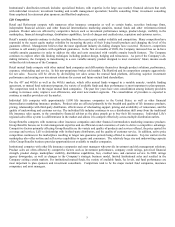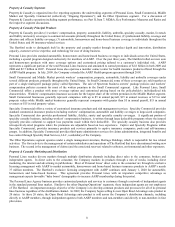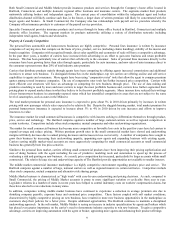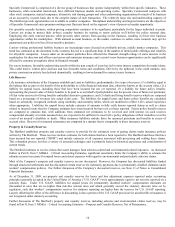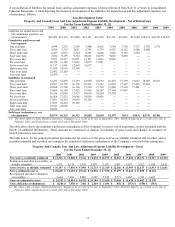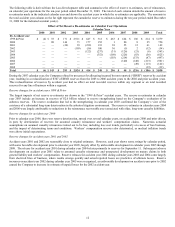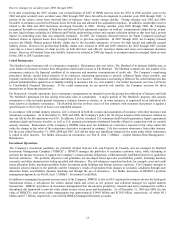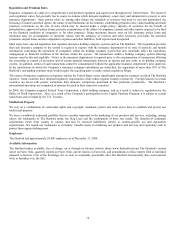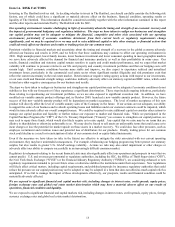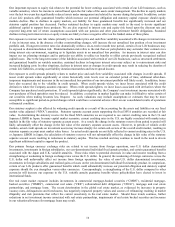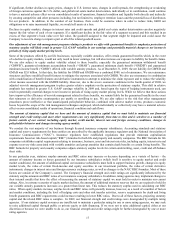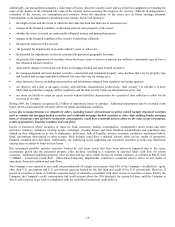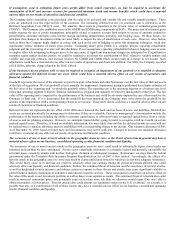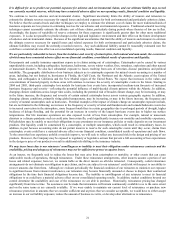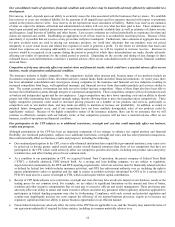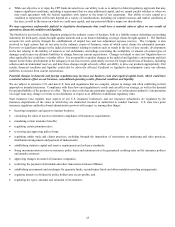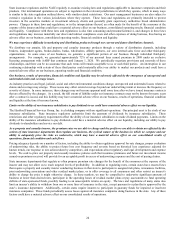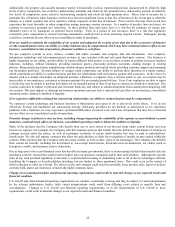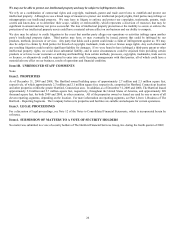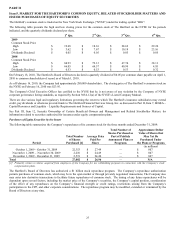The Hartford 2009 Annual Report Download - page 17
Download and view the complete annual report
Please find page 17 of the 2009 The Hartford annual report below. You can navigate through the pages in the report by either clicking on the pages listed below, or by using the keyword search tool below to find specific information within the annual report. 17
If significant, further declines in equity prices, changes in U.S. interest rates, changes in credit spreads, the strengthening or weakening
of foreign currencies against the U.S. dollar, and global real estate market deterioration, individually or in combination, could continue
to have a material adverse effect on our consolidated results of operations, financial condition and liquidity both directly and indirectly
by creating competitive and other pressures including, but not limited to, employee retention issues and the potential loss of distributors
for our products. In addition, in the conduct of our business, there could be scenarios where in order to reduce risks, fulfill our
obligations or to raise incremental liquidity, we would sell assets at a loss.
Declines in equity markets, changes in interest rates and credit spreads and global real estate market deterioration can also negatively
impact the fair values of each of our segments. If a significant decline in the fair value of a segment occurred and this resulted in an
excess of that segment’ s book value over fair value, the goodwill assigned to that segment might be impaired and could cause the
Company to record a charge to impair a part or all of the related goodwill assets.
Our adjustment of our risk management program relating to products we offer with guaranteed benefits to emphasize protection of
statutory surplus will likely result in greater U.S. GAAP volatility in our earnings and potentially material charges to net income in
periods of rising equity market pricing levels.
Some of the products offered by our life businesses, especially variable annuities, offer certain guaranteed benefits which, in the event
of a decline in equity markets, would not only result in lower earnings, but will also increase our exposure to liability for benefit claims.
We are also subject to equity market volatility related to these benefits, especially the guaranteed minimum withdrawal benefit
(“GMWB”), guaranteed minimum accumulation benefit (“GMAB”), guaranteed minimum death benefit (“GMDB”) and guaranteed
minimum income benefit (“GMIB”) offered with variable annuity products. As of December 31, 2009, the net liability for GMWB and
GMAB was $2.0 billion. At that date, the liability for GMIB and GMDB was a combined $989, net of reinsurance. We use reinsurance
structures and have modified benefit features to mitigate the exposure associated with GMDB. We also use reinsurance in combination
with a modification of benefit features and derivative instruments to attempt to minimize the claim exposure and to reduce the volatility
of net income associated with the GMWB liability. However, due to the severe economic conditions in the fourth quarter of 2008, we
adjusted our risk management program to place greater relative emphasis on the protection of statutory surplus. This shift in relative
emphasis has resulted in greater U.S. GAAP earnings volatility in 2009 and, based upon the types of hedging instruments used, can
result in potentially material charges to net income in periods of rising equity market pricing levels. While we believe that these actions
have improved the efficiency of our risk management related to these benefits, we remain liable for the guaranteed benefits in the event
that reinsurers or derivative counterparties are unable or unwilling to pay. We are also subject to the risk that other management
procedures prove ineffective or that unanticipated policyholder behavior, combined with adverse market events, produces economic
losses beyond the scope of the risk management techniques employed, which individually or collectively may have a material adverse
effect on our consolidated results of operations, financial condition and cash flows.
The amount of statutory capital that we have and the amount of statutory capital that we must hold to maintain our financial
strength and credit ratings and meet other requirements can vary significantly from time to time and is sensitive to a number of
factors outside of our control, including equity market, credit market, interest rate and foreign currency conditions, changes in
policyholder behavior and changes in rating agency models.
We conduct the vast majority of our business through licensed insurance company subsidiaries. Accounting standards and statutory
capital and reserve requirements for these entities are prescribed by the applicable insurance regulators and the National Association of
Insurance Commissioners (“NAIC”). Insurance regulators have established regulations that provide minimum capitalization
requirements based on risk-based capital (“RBC”) formulas for both life and property and casualty companies. The RBC formula for life
companies establishes capital requirements relating to insurance, business, asset and interest rate risks, including equity, interest rate and
expense recovery risks associated with variable annuities and group annuities that contain death benefits or certain living benefits. The
RBC formula for property and casualty companies adjusts statutory surplus levels for certain underwriting, asset, credit and off-balance
sheet risks.
In any particular year, statutory surplus amounts and RBC ratios may increase or decrease depending on a variety of factors – the
amount of statutory income or losses generated by our insurance subsidiaries (which itself is sensitive to equity market and credit
market conditions), the amount of additional capital our insurance subsidiaries must hold to support business growth, changes in equity
market levels, the value of certain fixed-income and equity securities in our investment portfolio, the value of certain derivative
instruments, changes in interest rates and foreign currency exchange rates, as well as changes to the NAIC RBC formulas. Most of these
factors are outside of the Company’ s control. The Company’ s financial strength and credit ratings are significantly influenced by the
statutory surplus amounts and RBC ratios of our insurance company subsidiaries. In addition, rating agencies may implement changes to
their internal models that have the effect of increasing the amount of statutory capital we must hold in order to maintain our current
ratings. Also, in extreme scenarios of equity market declines, the amount of additional statutory reserves that we are required to hold for
our variable annuity guarantees increases at a greater than linear rate. This reduces the statutory surplus used in calculating our RBC
ratios. When equity markets increase, surplus levels and RBC ratios will generally increase, however, as a result of a number of factors
and market conditions, including the level of hedging costs and other risk transfer activities, reserve requirements for death and living
benefit guarantees and RBC requirements could increase resulting in lower RBC ratios. Due to all of these factors, projecting statutory
capital and the related RBC ratios is complex. In 2009, our financial strength and credit ratings were downgraded by multiple rating
agencies. If our statutory capital resources are insufficient to maintain a particular rating by one or more rating agencies, we may seek
to raise additional capital through public or private equity or debt financing. If we were not to raise additional capital, either at our
discretion or because we were unable to do so, our financial strength and credit ratings might be further downgraded by one or more
rating agencies.


